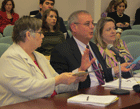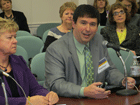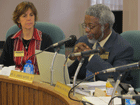
|
||
April 29, 2013
|
| MSDE Home | Newsroom | MDReportcard.org | School Improvement | | |
Maryland is fortunate to have so many terrific local system superintendents who work tirelessly to improve classrooms throughout the State. Dr. Jack Smith, superintendent of the Calvert County Public Schools, is one such educator.
Jack has been selected as Maryland's Superintendent of the Year for 2013, and the honor is well deserved. He's a great leader and a wonderful partner in our drive to strengthen our schools. * * * Working alongside our teachers, principals, and superintendents are Maryland's wonderful parent volunteers. Now is the time of year when we tip our hat to the thousands of individuals who have helped to make our public schools the envy of the nation.
* * * All three of Maryland's nominees for the U.S. Department of Education's 2013 Green Ribbon Award have received the honor. * * * Connect with MSDE on Facebook!
Calendar May 17 – Parent Involvement Matters Awards Presented, Eastern Technical High School, Baltimore County
News From The Board In the News Superintendent-to-Be is Ready for the Challenge Lockheed Martin Working with STEM Students in Prince George's County
State Board Revises Emergency Guide Maryland On Track to Meet Federal Teacher Evaluation Deadline Having trouble viewing this email? Click here for a PDF version of the MSDE April 29, 2013 Education Bulletin. If you would prefer not to receive future Newsletters from us, simply click here, and insert in the subject line, Unsubscribe. |
STATE BOARD APPROVES NEW EMERGENCY PLANNING GUIDE The Maryland State Board of Education last week gave unanimous approval to “Emergency Planning Guidelines for Local Systems and Schools,” a document designed to assist local officials in preparation and training for potential emergencies.
Safety is top most in the minds of educators throughout the State in light of recent news events. Maryland regulations require that all 24 school systems develop and implement emergency plans. Emergencies range from violent or traumatic events on school grounds during regular school hours to events in the community that affect normal school functioning. The Board’s action updates a document published in 2003. The new version of the publication will be a living document, updated regularly as needed by circumstances. The first edition of the guidelines has been utilized by all 24 Maryland systems to strengthen their emergency plans over the past decade. “The key to safe and successful schools is planning and practice,” said State Superintendent of Schools Lillian M. Lowery. “Schools and school systems must do everything in their power to keep students and staff free from harm. Every staff member must know what to do in the event of an emergency, and must have practiced his or her role.” MSDE staff developed the guide with the assistance of local school systems, Maryland State Police, Governor’s Office of Crime Control and Prevention, Maryland School Psychologist Association, Maryland Emergency Management Administration, Maryland Department of the Environment, Johns Hopkins Applied Physics Laboratory, and the Maryland Association of Boards of Education. “We wanted to know…where are the gaps? How do we address those gaps,” said Chuck Buckler, executive director, Student Services and Alternative Programs branch, MSDE. Emergency management is an organized process by which schools and communities prevent or mitigate risks, prepare for hazards that cannot be fully mitigated, respond to emergencies, and recover from emergencies and restore the school to its pre-emergency condition. The key to a well-functioning system is planning and practice, according to the guide. The focus on improved planning, as well for additional drills and other practice activities, represents improvements in the new version of the Emergency Planning Guidelines. In addition, the new document updates terminology commonly used in emergency situations. Work on the new version began last year. The revision adds new tools for local systems, such as information on technology hazards, threat assessment, universal drill procedures, and staff training. The complete publication is available on the web at the Emergency Planning and School Safety page.
The final version of the Next Generation Science Standards (NGSS) was being released earlier this month, a new set of voluntary, rigorous, and internationally benchmarked standards for K-12 science education. The standards can be found here: http://www.nextgenscience.org
Dr. Stephen Pruitt, senior vice president at education nonprofit Achieve, Inc., and a driving force behind the NGSS, met with the Maryland State Board of Education last week to discuss the standards. “These standards are meant for every student,” Dr. Pruitt said, adding, “These are a floor, not a ceiling.” The goal of the NGSS is to provide all students with a foundation in science that blends practice and content, allowing high school graduates to construct arguments based on scientific principles. Maryland is one of 26 states and their broad-based teams that have worked together for nearly two years on the standards, with a 41-member writing team and partners. The goal has been to develop standards identifying science and engineering practices and content that all K-12 students should master in order to be fully prepared for college, careers and citizenship. Dr. S. James Gates, University System of Maryland Regents Professor, John S. Toll Professor of Physics, and Director of the Center for String and Particle Theory at the University of Maryland—who also serves on the State Board of Education—said the new standards represent a great leap forward. “With the State of Maryland playing the role of one of the lead states in the adoption of the Next Generation Science Standards, we are poised to place the already considerable achievement of the state on a path toward excellence as measured on an international scale,” Dr. Gates said. The NGSS were built upon a vision for science education established by the Framework for K-12 Science Education, published by the National Academies’ National Research Council in 2011. The development of the NGSS was entirely state-driven, with no federal funds or incentives to create or adopt the standards. The process was primarily funded by the Carnegie Corporation of New York, a leading philanthropy dedicated to improving science education in the U.S. The NGSS are grounded in a sound, evidence-based foundation of current scientific research—including research on the ways students learn science effectively—and identify the science all K–12 students should know.
|
||||||
|
|
|||||||




